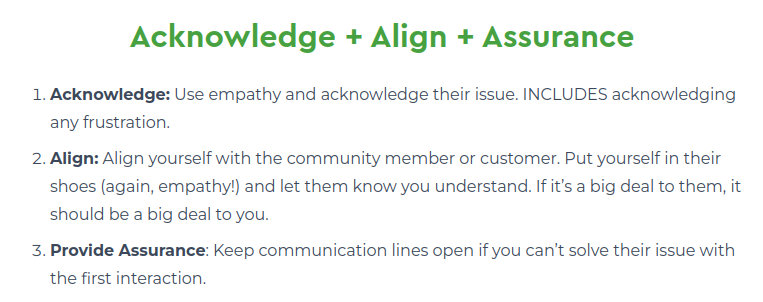Social customer care trends 2024: an interview with Brooke Sellas

Article summary
In this interview, we talked to Brooke Sellas about the current state of social customer care, the best part of customer care automation, and her upcoming book "Conversations That Connect".
Listen to this interview!
What is a customer-centric business strategy
Anna: My first question may seem like a bit of a wide one, but I think it's important to start from the basics this time. What are the features or characteristics of a customer-centric business strategy?
Brooke: I'm going to answer your question with the question. Have you read Jim Collins' book "From Good to Great" and seen his flywheel?
Anna: No, I don't think I have.
Brooke: We took the flywheel that Jim Collins created and made a new one where the customer and social customer care are in the center of the flywheel and they drive growth.

The reason why it drives growth is the following idea. Think about how many people are using digital media to shop, research, and make buying decisions. We know that over 80%, at least here in the U.S. of people use social media to help with purchasing decisions.
So we recreated the flywheel and put social and customer care in the middle, which means we're talking to people throughout their entire digital customer journey.
We're talking to them when they're making those acquisition questions, like, "Do you offer free shipping?", "Do you have this in my size?"
Those are buying questions. Those people are in the buying moment. And if you can answer them quickly, you can hopefully acquire them as a new customer.
But then if you go all the way through the flywheel to retention, a lot of people are now using social media to ask those retention support questions. Essentially we're looking at social media to drive growth within the company through social and customer care each step of the way.
Anna: Yeah, I think it's important to look at this on the whole.
How to market with empathy
Anna: You recently hosted a talk titled "Marketing with Empathy". What does this phrase mean to you? Do you have any tips for businesses on how to market with empathy?
Brooke: A lot of people think about these questions that come through on social and they want to use a bot. I have nothing against bots. I think chatbots are wonderful when they answer very transactional questions. For example, "Are you open today?", "What are your hours today?", "Where are you located?"
But if you go into a business that has more nuanced questions, like "Is my doctor in-network?" or "What am I going to have to pay for my tax return?" Those are nuanced questions that a bot probably can't answer because they require empathy.
Essentially, we have a formula that we use a B Squared Media and it's called A Cubed.

It goes: acknowledge, align, assurance.
So you acknowledge the question by using empathy and acknowledging the issue.
Then you align yourself with that customer and put yourself in their shoes, meaning empathy. Let them know that you understand it's a big deal to them.
And then the third one is assurance. You want to provide assurance, so you want to keep the lines of communication open, even if you can't solve their problem right. Give them a timeframe and then beat that time frame. Come back in 15 hours instead of 24 with the answer.
So that would be the formula that we use, acknowledge, align, and assurance. With that, we make sure that we're using empathy at every corner of those questions.
Smart marketing automation: DOs and DON'Ts
Anna: Speaking about automation, do you think there is a particular moment in business development where you should introduce automation to customer care? Does it depend on the size of the business?
Brooke: It's really throughout. It does depend on the company, not on its size but the types of conversations that you receive.
If you're just starting out and you're thinking about using social media for customer care, just start tracking all of the conversations that you get. You could actually do this through a tool or you could go natively by going into your native Twitter business account or any other social channel and pulling out all of the incoming messages that you receive.
Then go through all of those questions and conversations and start to give them tags.
They can be acquisition questions, meaning these people have pre-purchase questions.
They can be retention, meaning these people are likely customers and they have support questions.
Then you can also go through and start to see what kinds of questions are getting asked and if there are some frequently asked questions you can certainly set up a bot to answer those questions and take the load off of your human team.
But if you see that every question is different and every question requires several steps as an answer then you may have to say to yourself that automation may not work at any point in our process.
Thanks for reaching out. Our team will review your message as soon as possible.
— Apple Support (@AppleSupport) April 27, 2022
In the meantime, you can find helpful information about AirPods here: https://t.co/LAwuWOw7q1
Maybe you can use automation to send out a thank you email once they schedule.
But maybe it doesn't happen early on when those nuanced questions are getting asked.
Anna: You mentioned tracking those customer questions. Last time we spoke, you also told us about using social listening for customer care. I was wondering about your own social listening routine. What do you do when you run social listening for a client?
Brooke: We live inside of our social listening tool like 24/7!
I think the number one advice that I would give to people is around that acquisition and support. When it comes to organic social media, the the C-suite, the higher-ups, the company leaders, they still don't quite understand the value in organic social media. A lot of them are like, we know we have to do it, but it doesn't provide any value.
I think one of the first things you could do with a social listening tool is start to tag all of those incoming questions as acquisition or retention.
We did a project where we asked all of our social customer care clients, "How much of your social chatter do you think is acquisition?" meaning how much of your social conversation online is people pre-purchase? They're in the buying moment and they're asking you questions because they may buy from you.
Our clients said 0 to 5%. So we started to use a social listening tool to tag all of the incoming conversation as acquisition pre-purchase or retention post-purchase. And what we found was that every single one of our clients had over 20% acquisition chatter happening on social. Some of them had product lines that were over 60% acquisition, some of them as high as 80%.
So now we're working with their sales team to look at those questions that we got for acquisition and create better and more engaging nurture sales content to help close the deals on social.
How to amplify conversational marketing
Anna: Yeah, conversations are important and you even wrote a book about that! What inspired you to write "Conversations That Connect"?
Brooke: I'm so excited! The books should be coming out at the end of May or mid June.
Essentially it is "Conversations That Connect: How to use social and customer care get better at social media". It's been a long time in the making.

I actually did my undergraduate thesis work on this concept called the social penetration theory. Basically two social psychologists in the seventies asked how do we form relationships? How do we build trust?
What they found was that we build trust and relationships by disclosing information to one another. I tell you something about me that you don't know. And if you align with and like that information, you share information with me. And if I align with and like that information, we move the relationship forward.
They actually said that there's four levels of disclosure:
-
clichés,
-
facts,
-
opinions
-
and feelings.
Cliches and facts really don't do anything to build trust. And guess where most brand content lives? Cliches and facts! Right?
The book starts with the why and how to get more into sharing opinions and feelings and asking for opinions and feelings from your audience, your community, and all of the different segments that you have.
And then part two goes into the how. I explain how we use social listening, how to set it up, etc. I give several case studies like the coffee story throughout part two of the book.
Essentially it's a two part process. We have to get better with our content because it's very cliche- and fact-based. We have to start aligning our brand goals with the goals and the values of our customers and vice versa.
And then we also have to start using tools like social listening and tactics like social customer care to have more of those opinion and feeling based conversations, to see those conversations and bring in social intelligence and data so that we can make more innovations based on the voice of the customer. We all think we know what the customer wants, but we're not really looking at the data to find out what they actually want and then giving them that.
Anna: Can't wait to read it!
The future of social customer care
Anna: In the marketing industry, we are always trying to predict the future and guess what will be the next big thing. So I wanted to ask you, in your opinion, what will be the future customer care trends?
Brooke: I think we've already started to see what the future's going to look like.
We saw that during the pandemic, more and more people moved to social media. Even some of the baby boomers, some of those older generations who kind of held out, were forced to go online. And they started shopping online during the pandemic as well.
We've seen an explosion in what's happening with shopping online. There's live conversational commerce. There's social commerce. You can now buy with such ease without ever leaving the comfort of your home, which we know that the younger generations really like to do.
We also know the Metaverse is being talked about widely, and it's essentially all of these activities, events, shopping, concerts happening online.
But guess what? As with all things as humans, if we need help, typically we want a human there to help us. So I think the only thing that's going to change is that you need to start preparing for social-led customer care now if you haven't already. Because as these things continue to grow, the Metaverse, all of these online shopping availability and one-click purchasing, more and more companies need to put some effort into social and customer.
Both for that acquisition, getting new customers and keeping the ones that they have.
Awario Marketing Talks Blitz
Anna: Now it's time for the Marketing Talks Blitz! What's the first website you open in the morning?
Brooke: Oh, this is boring. Microsoft email.
Anna: And in terms of content?
Brooke: Oh, Twitter. Hands down.
Anna: Yeah. For customer care, what do you prefer, email or chat?
Brooke: Chat, I would say even social. But if it's email or chat, I would say chat because I, I just like the little details.
Anna: What's your favorite social media platform at the moment?
Brooke: It's a toss-up between Twitter and LinkedIn. I love Twitter. Twitter's always been my number one, but LinkedIn lately has been coming in a close second.
Anna: And the last question, where can our listeners find your book and also find you online and follow you?
Brooke: Absolutely. You can go to B Squared Media website. And then for the book, you can see it there on the website or go to bit.ly/B2book.
And you can find me on Twitter or LinkedIn!













